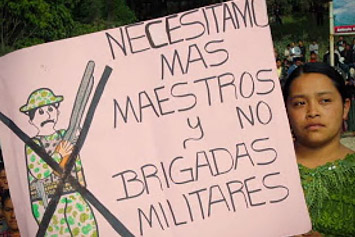Mobilising for a quality education that meets Indigenous Peoples needs
On International Day of the World’s Indigenous Peoples, EI reaffirms the right of indigenous children to education and the right of indigenous peoples to self-determination, also to define education systems and quality education integrating their own perspectives on culture, beliefs, values and languages.

"We don't need squads, we need more teachers"
Quality education should empower and strengthen indigenous children’s ability to exercise their civil rights, to influence political policy processes, and to tackle burning issues such as poverty, health and sustainable development.
“It is crucial for education unions and the trade union movement to ensure that human rights and the right to education are not achieved at the detriment of the human rights of 370 million Indigenous Peoples” according to EI General Secretary, Fred van Leeuwen.
Education unions and teachers can play a role by involving indigenous communities’ representatives as equal partners in the discussions and decision-making processes related to education.
Indigenous children fare poorly compared to others
In 2000, governments around the world committed to realising Education for All (EFA) and the Millennium Development Goals (MDGs) by 2015.
Although progress has been made, there are still 61 million children of primary school age who are not receiving an education. Children from ethnic minorities and indigenous groups are the largest group at risk of not attending school. Indigenous students have lower enrolment rates, higher dropout rates and poorer education outcomes than non-indigenous people in the same countries.
In Guatemala, for example, 53.5 per cent of young indigenous people aged 15 to 19 have not completed primary education, compared to 32.2 per cent of non-indigenous youth.
The study released by the Canadian Centre for Policy Alternatives, Poverty or Prosperity. Indigenous Children in Canada (June 2013), found that one in every two Aboriginal students live in poverty, more than three times their non-Aboriginal counterparts. This means that half of all Aboriginal children are at a greater risk of struggling in the classroom.
Change of attitude in education required
The indigenous peoples’ experience is that most education systems and available curricula do not, at best, reflect their cultures and values; and, at worst, devalue their competences, cultures, languages and lifestyles.
“Public education systems have the potential to provide indigenous peoples with the skills to enact social change,” said Darcel Russell, Deputy General Secretary of the Australian Education Union (AEU) and Chair of EI’s Steering Committee on Indigenous Issues.
“But this requires an attitude whereby education systems affirm the Indigenous identity and educate non-Indigenous about the diverse and unique histories and components of our communities."
In September 2014, the United Nations will convene a World Conference on Indigenous Peoples. In the lead up to the conference, recommendations have been adopted at a preparatory meeting held in June in Alta, Norway.
EI invites its affiliates to learn about the Alta recommendations and to consider how they can become more aware of activities on non-discrimination.
Source: Education International
- 522 reads
Human Rights
Fostering a More Humane World: The 28th Eurasian Economic Summi

Conscience, Hope, and Action: Keys to Global Peace and Sustainability

Ringing FOWPAL’s Peace Bell for the World:Nobel Peace Prize Laureates’ Visions and Actions

Protecting the World’s Cultural Diversity for a Sustainable Future

Puppet Show I International Friendship Day 2020

